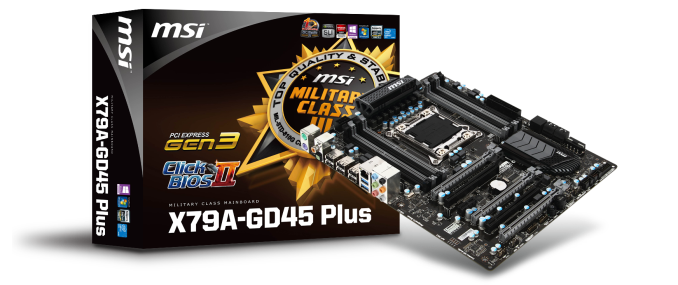MSI X79A-GD45 Plus Review: Building Up
by Ian Cutress on February 14, 2014 10:00 AM EST- Posted in
- Motherboards
- Intel
- MSI
- X79
MSI X79A-GD45 Plus Conclusion
When a motherboard manufacturer designs a product, they have an Intel specification to work with based on the socket used and the chipset to be used. This defines the basic list of ports to be included, and anything beyond this requires planning and investment in additional hardware. When speaking to motherboard manufacturers, the whole process from specification to mass production can take 8-12 months, meaning that manufacturers have to predict the needs of the market in advance. What gets put onto the motherboard over and above the Intel specification comes in two flavors – direct enhancement and indirect enhancement.
Direct enhancement gives more immediate features to the user. This means more network ports, more SATA ports, more USB 3.0, fan controls, a better PCIe layout and what comes in the box with the product (cables and so forth). These are features we can quantify and provide in a list, such as types of video output, or buttons directly on the motherboard.
Indirect enhancement is harder to quantify. Features that come under this heading include power phase counts, routing around the motherboard, sound enhancement, heatsink placement and stability. Each one of these is hard to test, or requires a statistical variation to provide an accurate sample. Nonetheless, indirect enhancement is a fundamental feature of the motherboard to provide a base to which motherboard manufacturers compete against each other.
For indirect enhancement, MSI has pushed the socket area down on the motherboard to give more space to components, at the expense of a PCIe x1 slot. MSI use a base Realtek audio codec and an Intel NIC for a $250 product, both of which are standard off-the-shelf components. In the direct enhancement camp, we have no additional controllers to play with, although a full complement of SATA cables is in the box, but only one SLI bridge despite the 3-way GPU layout.
MSI are attempting to bolster their position by providing an aesthetically pleasing product, as well as on the software/BIOS side. I have to commend MSI on Live Update which still requires an equal, and despite the issue of being able to set 1.8 volts on the CPU in software all too easily, the rest of the package (RAMDisk) is decent enough. It is a shame I could not get OC Genie to display any difference against a standard stock+XMP setup however.
Performance wise, due to MultiCore Turbo being enabled by default when XMP is applied, the X79A-GD45 Plus performs well in our new benchmarking suite, taking advantage when other products falter. Unfortunately our overclocking results were stunted by a relatively poor CPU and we hit a temperature limit early on.
With Ivy Bridge-E bringing little more to the table than a small IPC improvement, there are relatively few X79 refresh motherboards because the chipset is showing its age. We have reviewed a couple of the new ones, and they offer reasonable starting points for people jumping onto Intel’s enthusiast platform due to being designed for Ivy Bridge-E. At $250, MSI is aiming for the lower end of the spectrum in X79, although there are cheaper boards still available we have reviewed [1,2] as well as some that have won awards and are ~10% more expensive [1]. At this price point, users will end up purchasing for that one specific feature that a motherboard might have, or with their allegiance to a particular manufacturer. The main selling point for the MSI X79A-GD45 Plus, apart from its release aimed at Ivy Bridge-E, will be the PCIe layout with full eight DIMM memory support.












44 Comments
View All Comments
devdollers@gmail.com - Friday, February 21, 2014 - link
nice board again........chuonglb - Thursday, March 6, 2014 - link
too great, great for plowing games...kizi: http://www.kizi10games.net
friv: http://www.friv200jogos.org
yepi: http://www.yepi10games.org
Jogos Friv - Sunday, May 4, 2014 - link
I have participated in many forums but there is little shared the forum or post it as your very helpful for me I have learned so much through your share thanks aJogos Friv : http://www.jogos-friv.biz/
lovethus - Thursday, August 14, 2014 - link
Many thanks for sharing this, I will share with you their references. Many thanks.http://www.yepi10games.net
http://www.huz10.org
http://www.friv2-kizi.com
http://www.g9ggames.net
kuteboys - Thursday, August 21, 2014 - link
I appreciate it matters breakthrough in 2014 thank you for sharing this information.http://www.frivcode.com | http://www.kizicode.com | http://www.yepicode.com
kutelove - Tuesday, August 26, 2014 - link
I agree with your information and I hope everything will be better, good luckhttp://www.frivgamesls.com
sosolo - Wednesday, October 15, 2014 - link
I like your information. Construction activities, including construction planning, setting up investment projects construction, construction surveying, construction design, construction works and construction supervision of construction, project management of construction investment, selection of contractors in construction activities and other activities related to construction.!sharkyboy - Saturday, January 3, 2015 - link
actual supported RAM is 128GB check the vendor sitehttp://www.msi.com/product/mb/X79A-GD45-Plus.html#...
sharkyboy - Saturday, January 3, 2015 - link
does the motherboard support VT/HT for virtualization?Thanks in advance
Crimson Ryoka - Sunday, January 4, 2015 - link
Does anyone notice how this article shows how much an amd 7850k can compete with i7s cost for performance. sub $800 a complete 7850k r9 290 build can be achieved, thats insane